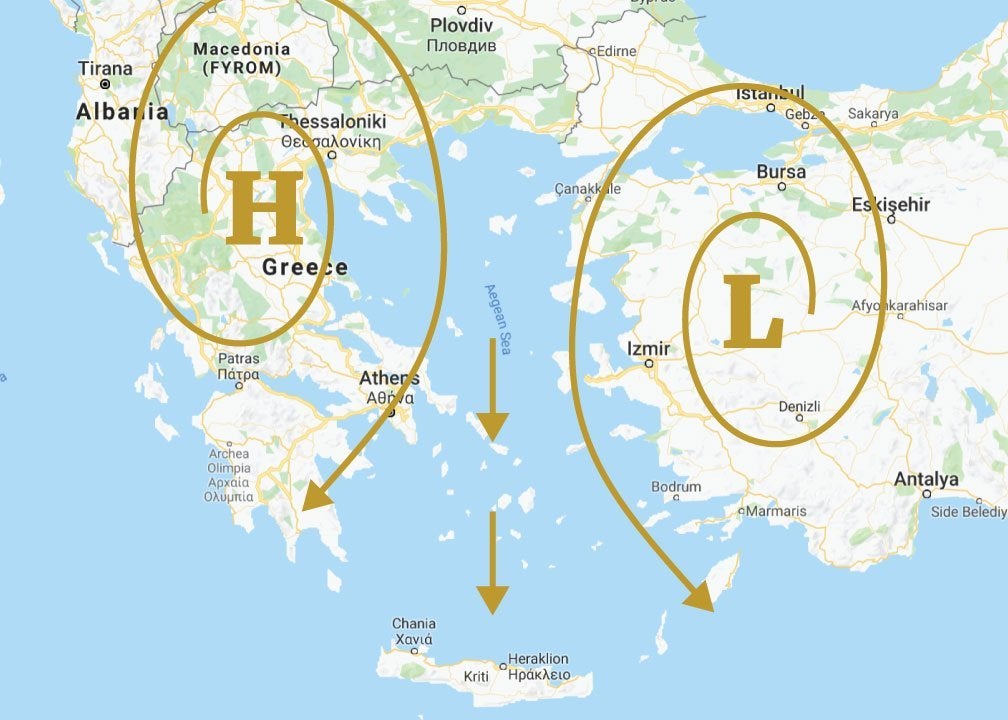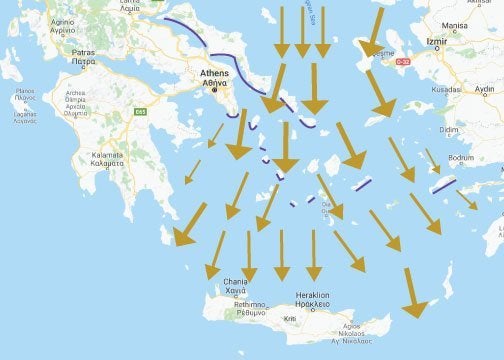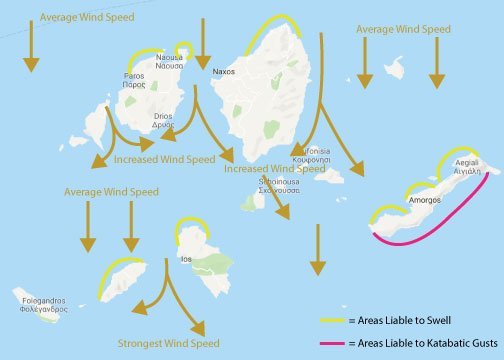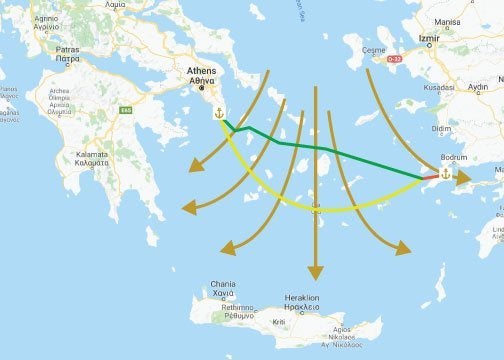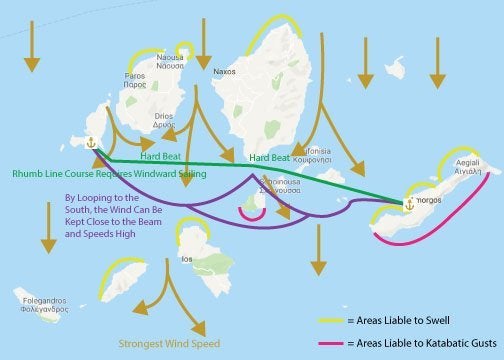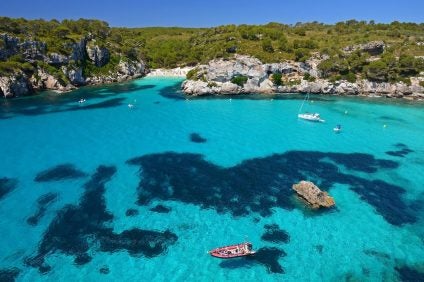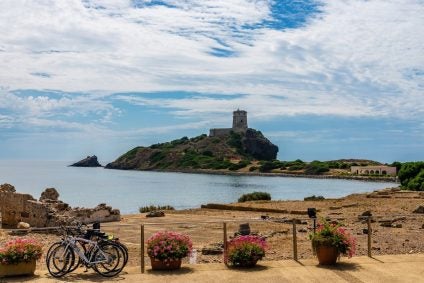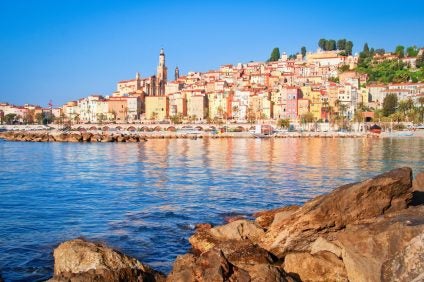Welcome to Greece and the famous Meltemi, which has a reputation among sailors, just like the Bora in Croatia and the Xmas wind in the BVIs. While its reputation can be off-putting, don’t let it deter you. As with any sport, there are degrees of difficulty, and although the inexperienced should not tackle a strong Meltemi without skilled guidance, for the keen and experienced sailor these summer winds can provide exhilarating sailing. Master mariner, Julian Blatchley has sailed the Greek islands since the 1980s and has detailed in his second blog for us ways to make the best of the powerful Meltemi and where to sail when the wind is strong. If you missed his first blog, check out Where to sail in the Greek Islands.
Understanding the Meltemi
The Meltemi blows south over the Aegean when low surface pressure over Turkey meets high pressure over the Balkans. Its strength depends on the barometric pressure difference between the two systems and a typical difference of around 15 mb can give Meltemi winds of about force 7 Beaufort in open sea areas. The Meltemi winds are most common in July and August, when they can be almost continuous. They can also occur less frequently from late May to mid-September, and occasionally even into October. The length of a Meltemi varies, but is commonly between three and six days.
The Meltemi is broadly considered to be a north wind, but the winds tend to follow the lines of the Greek and Turkish mainlands. In fact, it is truly a north wind usually only in the central Aegean. The western Aegean experiences a north-easterly and the eastern Aegean a nor’wester.
From ancient times it has been recorded that the Meltemi rises in the morning and dies down at night. When I first went to Greece over thirty years ago, winds would peak early evening and die as the sun set. Then we would be fairly confident that we could set sail and motor north before winds started to build at 10am. Whatever your views on climate change, I have to tell you that daytime falls in strength do not always occur today. You may encounter them, you may not, but don’t rely on it.
Effects of a Meltemi
What can you expect from these winds:
- Open water wind speeds of typically force 6-8 Beaufort
- Increased wind speeds in narrow channels, reduced wind speeds on the Peloponnesian and Turkish coasts
- A northerly – north-north-easterly wind over the north Aegean and a diverging wind pattern in the south Aegean
- Open water combined wave heights of 2-4 metres and the highest seas are found in passages between the islands of the central Aegean
- Confused seas close to windward shores and very strong katabatic down-drafts on the lee side of mountainous shores
The size of the arrows roughly represent wind strength and the purple lines show likely dangerous katabatic areas, where winds are usually fairly calm except when violent gusts actually strike. Now let’s take a closer look at how winds react to meeting a rocky island group and I have chosen the always-popular Paros-Naxos-Amorgos area of the south central Aegean:
- The wind-flow close to the islands behaves in a similar way to that across the whole Aegean Sea – winds increase in the narrows and deflect towards the coastlines, as shown in the diagram above
- Areas where katabatic winds may be expected are shown in pink – I strongly recommend that you keep clear of these coasts by at least two miles whenever there are strong northerly winds, and keep close watch with binoculars for any approaching spray or white water. If you must go into these areas in strong north wind, then lower and secure all sail, use motor only, secure any loose equipment on deck (especially dinghies), close all watertight openings and have all crew in lifejackets.
- The north side of any island can be assumed to be affected by reflected swell (shown in yellow). Minimise time in these areas
If this sounds daunting, don’t worry. There are ways to manage these winds and enjoy some spectacular sailing in Greece. This famed north wind is not all bad and brings clear air, welcome cooling during the furnace of summer and it can make a well-handled sailing boat fly like an arrow. Also, remember that the Aegean is otherwise very free of hazards with no significant tides, light currents, few shoals and fog in summer is almost unheard of. If you can handle the wind, you’ve got it licked!
How to ride the Meltemi across the Aegean
Unless your whole crew are sailing purists, sailing to windward in strong winds and a high, steep sea is not something you will want to spend your summer sailing vacation doing. To avoid this, keep the wind on the beam – and you can do this if you remember that the winds tend NE’ly in the west and NW’ly in the east.
Let’s say that you want to sail from Lavrion or Alimos to Kos. From a common departure point off Cape Sounion, the direct rhumb line course (shown in green in the image above) will involve some heavy windward sailing over the first half of the voyage. It passes through some windy straits and close to a few lee shores, and just as the wind starts to come abeam you will find the highest seas in the gaps between the islands. If the Meltemi is at even average strength, frankly only a masochist is going to want to bring that boat back again. So – don’t sail rhumb lines!
You can keep the wind-free if you trade a little extra distance for much greater speed and far better sailing (see the yellow line on the image). And, as a bonus, you get a wider choice of destinations for the itinerary too.
This ‘grand strategy’ for crossing the Aegean can also make your daily sailing through the islands more enjoyable and faster. Let us now imagine that you have woken up in the lovely anchorage at Dhespotico, and you’re going to sail to Katapola on the elemental island of Amorgos. You can use the same game plan for getting around the islands.
By taking the rhumb line, you will start by banging to windward in a short sea and you will find stronger wind. Even when the wind backs for you, you will have more beating ahead. Yet, if you free off and loop to the south (see the purple line on the image above), you will sail fast on a reach, find less wind, and you can make your ground to the north as the wind backs. A much more pleasant experience. Just take care to stay out of the likely katabatic areas (marked above), which means staying at least 2-3 miles offshore.
Should you sail in the Meltemi?
Well, first of all, we’re here to enjoy our sailing. Surviving the Meltemi is one thing, enjoying it is another. I hope that I have shown you that sailing the Meltemi can be a thrilling and satisfying experience, but we are all different. For whatever reason – kids on board, inexperienced crew, or simply a penchant for the quiet life – some of us may not wish to tackle high winds and seas. That’s fine… many people like to go for a walk, but not everyone wants to do the Oregon Trail.
I would say that, if you have sailed across a full trade wind in the Caribbean and enjoyed it, or if you can manage the Gulf Stream in a northerly, then you’ll be OK in the Meltemi. And if you don’t come into those categories, but still want to sail the pristine Aegean, to gaze upon the blue-domed churches and cute donkeys that have launched a thousand calendars, to sip ouzo in the shade of an olive tree with your feet in an azure fish-tank, then you still have options:
- Sail in May/early June or September-October – avoid July and August
- Take a skipper for the first few days to help you settle in
- If you don’t like it, make for the Argo-Saronic (I will be writing separately about this area, so keep watching the blog)
- Take the down-wind route and return northwards via the Peloponnese (watch for my blog Sail the Aegean the gentle way).
Tip summary
Follow my guidelines and you will be able to enjoy your evening cocktail in the rosy after-glow of the incredible experience that is sailing the Meltemi:
- Don’t sail rhumb lines
- Keep the plan flexible and re-evaluate constantly
- Don’t be afraid to loop southwards to keep the wind on the beam
- Make ground to the north whenever you comfortably can
- Don’t get too close in the lee of the land
- Avoid, or minimise time in, reflected swell areas
- Pre-prepare food & drink for the passage (cooking in beam seas is not often fun; let the cook enjoy the day too)
- Keep in open water as much as possible
- You probably won’t want the spinnaker!
About Julian
Julian chartered a sailboat out of Alimos Marina, Athens in the 1980s and slightly over-stayed, returning home in 2014. During the intervening time he worked as a charter and delivery skipper for six years, and sailed a number of his own boats in Greece. He has contributed to sailing guides for Greek waters and is the author of two light-hearted books on the pitfalls of sailing in Greece, Adjacent to the Argonauts and The Trojan Walrus. He continues to sail the islands in his 45ft Starrett sloop and will be back with more insider knowledge on sailing in Greece.
Find out more
Take a look at our bareboat fleet, or get in touch with our team. Email us at [email protected] or give us a call at 855.650.8902.

